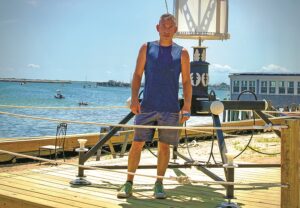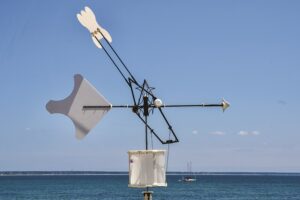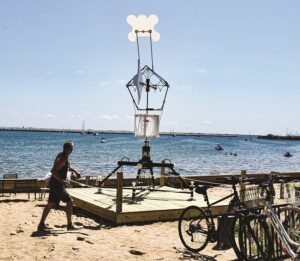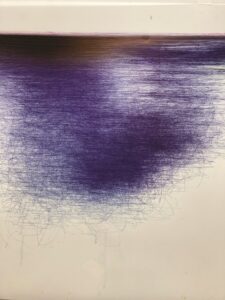Every Wednesday, Andrew Mowbray travels from Boston to Provincetown, where he finds a drawing produced in collaboration with the wind and his sculpture Tempest Prognosticator.

“I get to open this present and see what the weather did over the past week,” says Mowbray. He also enjoys interacting with people checking out his project. People are curious, he says. Is this art? Is this science? “I like that it sits in that gray area,” says Mowbray. “It’s a functioning weathervane that creates a record, but at the same time it’s creating a drawing.”
The kinetic sculpture, on view through October and supported by a grant from the Provincetown Public Art Foundation, sits next to Angel Foods in Provincetown’s East End. Inspired by Victorian-era devices used to record weather, it derives its name from an ornate 19th-century barometer that George Merryweather designed using leeches, a whale bone, small hammers, and a bell to predict storms.
Mowbray admires the 19th century’s spirit of experimentation, its transcendentalist fascination with nature, and its fluid borders between the arts and sciences. In other projects throughout his career, Mowbray has alluded to this time period with objects that address functionality. In one series he used Tyvek Home Wrap — intended to insulate buildings — to create images referencing Americana quilts and samplers. In another project he looked to the Shakers for inspiration, borrowing from their “refined aesthetics, craft, and utility” to create a collection of wooden milk crates.

The sculpture in Provincetown is both imposing and whimsical. Constructed of black steel, it stands approximately 19 feet tall. Two paddles cut in playful, decorative shapes from white polyethylene dominate the top. One arrow-shaped paddle attached to a metal bar points in the direction of the wind. Another moves up or down vertically according to the strength of the wind, triggering the movement of a Mylar-coated plastic drum at the heart of the sculpture.
Inside the drum, a stationary pen marks up the Mylar. When Mowbray inspects the drawings at the end of the week, he gets a record of the wind’s activity: the horizontal movement of the scribbles denote the wind’s direction, and the vertical movement of the marks denote its strength. Each day is represented by a different color. (Samuel Tager, executive director of the Provincetown Public Art Foundation, changes the pens daily.)
The resulting drawings, which Mowbray and the PPAF hope to exhibit, nod to a different time period altogether. The erratic scrawls recall the work of the Abstract Expressionists. Although originally created in 2009 and displayed at the DeCordova Sculpture Park in Lincoln, the sculpture’s current placement brings a new set of associations.

“The drawings speak to the history of Abstract Expressionism here,” says Mowbray. He had recently visited the Provincetown Art Association and Museum, where he admired a Helen Frankenthaler piece that recalled the Provincetown landscape through its colors and gestural lines. “There’s something about Provincetown and this place,” says Mowbray. “Artists are here for a reason. You cannot deny the landscape and the weather, and I think for a lot of artists they feel they have to address that in their work.”
The placement of his sculpture by Provincetown Harbor allows Mowbray to feel more in tune with the landscape of the Outer Cape, not unlike the scores of plein-air painters and abstractionists who made art out of a direct experience observing the harbor. “The wind is so clean here,” he says. “When I look at the drawings, I can really tell what’s going on.”
In one drawing a chaotic black hole dominates the composition, a record of a stormy day with torrential downpours and high winds. He enjoys approaching the sculpture and seeing how the horizontal thrust of the drawing echoes the horizon line where sky and water meet. And although he’s limited to the nine colors of the Fisher Space Pens he uses, he sees the standardized colors of turquoise, purple, blue, and burgundy reflected in the landscape. “When I look out, I can see those colors,” says Mowbray.

A desire to connect with nature motivated the creation of this sculpture. “I was really inspired by the transcendentalists,” says Mowbray. “I was living in Boston, and this came out of a frustration with not being in the natural environment. I wanted to record the weather in my own way and have a more direct experience.” He wanted to do something more authentic than check the weather by looking down at his phone. Ironically, however, his solution involved another type of distancing technology — although one that is decidedly more low-fi.
What distinguishes Mowbray’s work from that of most others who have been inspired by the Provincetown landscape is a sense of remove built into this performing sculpture. His experience of the landscape is secondhand, mediated by the device he created. He comes away with a new drawing each week — a drawing of the weather in Provincetown — but it’s created while he is going about his life in Boston or wherever he happens to be.
The new context of the sculpture not only introduces associations with the landscape and the history of art-making in Provincetown but, more than a decade removed from its original installation at the DeCordova, it also inhabits a new technological era in which AI is quickly transforming how we understand cultural production. In this context, the sculpture looks both forward and backward in time.

The drawings it produces are gorgeous. They seem to vibrate with the impassioned gestures of the human spirit, like their abstract-expressionist antecedents. But there is no hand making these drawings. It’s wind, which Mowbray describes as “a sort of magic.”
“We don’t see it,” he says. “We see it by other objects.”
On one hand, an artwork created by the force of nature is very 19th-century with all its sublime, spiritual associations. On the other hand, the mechanics of the device call into question the artist’s authorship. The death of the author is not a new concept, but in our new technological age, these anxieties are felt all the more acutely.

Whatever direction art takes, Mowbray’s sculpture offers a vision where an artist’s intent and technology work seamlessly to create objects that still resonate with beauty and intrigue. “Unpredictability is the thing I like about art,” says Mowbray. “I can build this and then it’s done, but having something that is unpredictable or shows you something else that you didn’t realize before is really great.”



